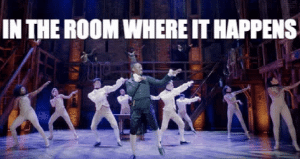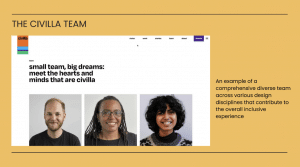Day 2–Streamlining and Inclusive Design Practice

— Hi everyone, I’m so excited to be here and thank you for the intros
— I will talk on streamlining an inclusive design practice and thanks to Rosenfeld for curating the conference and entire theme cohort

— I will give a brief agenda:
-
Idea of performative equity
-
The forgotten practice of inclusive design
-
Being in the room where it happens
-
Final reminders

— I want to bring up fact that this piece is also about me and value of DEI work. In addition to my professional role, I’m also a:
-
Yogi
-
Outdoor Adventurer
-
Curly Hair Lover
-
Community Educator

— Will talk about where we were in DEI and where we currently are, what inclusive design isn’t and how to implement it
-
Who needs to be in room for inclusive design

— A brief trigger warning on the following image to illustrate to show the impacts of 2020
-
It’s an important photo to amplify the message sent today

— As you are aware 2020 was a year, in a lot of different ways, and came with broken promises and commitments to respond to the social unrest that happened
-
Pertinent to DEI space due to the discussions and lip service given that year

— I’ll lead with some facts
-
First, 56% of DEI roles increased after 2020 timeframe

— But 2022 layoffs led to the attrition of 33% of DEI roles, compared to more than 12% of non-DEI roles

— And a study by Villio Labs showed 300 DEI professionals left companies in late 2022

— These are signals that companies aren’t making DEI a future priority
-
So were all of these commitments real?

— Actions like this led to people questioning the concept of performative equity and seeing how companies have no real inclusion policy
-
A person can advocate for equity and inclusion and have no practical action taken
-
Or DEI group being hired and then being let go
-
Or hiring head of DEI, but giving them no resources, budget, or leadership access
-

— For example, I believe land acknowledgment can be inclusive and give respect to people who occupied lands before we did
-
But we need to acknowledge that while land acknowledgment inclusive, there is a performative aspect of it
-
There is risk of just reading off piece of paper and action from a checklist, rather than putting the material within the practice
-

— This leads us to the forgotten practice of inclusive design, which as seen as last priority or lip-service
-
Inclusive design implementation has been detrimental

— Examples of this poor implementation includes:
-
Marking A Checkbox: Marking an item off a list rather than being about interpersonal work, which should be long term
-
Being One Person’s Job: Having one person carry load of the equity practice
-
No Accountability: People are not held responsible for failing to implement DEI

— Other approaches include:
-
Designing for One Community: Example of inclusive designing for one community
-
Only About the Product: Exclusive focus on product instead of having employee experience
-
ID Being Equal to Accessibility: Assume ID is about accessibility

— However, there are a few inclusive design practices I truly value
-
Pause and Effect is a company committed to servicing people globally

— Pause and Effect focuses on relational design
-
You have heard of HCD of centering humans and their needs
-
The relational approach is to center all beings, and planning for current and future beings

— Other practices include the Creative Reaction Lab

— Inclusive design isn’t linear, but circular
-
Continuous focus on unraveling history and systemic issues and acknowledging co-design for products

— So how do we achieve these practices, as organizations and individuals?

— The easiest way to explain this is phrase of ‘dust off your trophy’
-
There are principles and systems we create can be a living document that we implement and use continuously
-
The document iterates as we grow and mature and change
-
It shouldn’t keep you from evolving
-

— I’ll bring the analogy of going to the DMV, to build out an inclusive design practice:
-
Four main steps for application

— Step One: Who you are and not what about
-
Bring people along and create foundation for way to establish and create inclusive design and written document statements

— Step Two: Streamline the inclusive design within existing design system and illustrations
-
Foundation is building trust and safety, where things like technical jargon causes frustration and anxiety
-
Introduce solution-based action
-

— Step Three: Rethink design process, and ask how our solution is impacting customers and target audience in the room
-
Ask who are we missing and not addressing
-
There is harm in solutions not taken
-

— See the example of ethical researchers checklist and understanding and eliminate all harm but reduce as much as we can
-
This checklist is a starting point

— Step 4: Having required checkpoints in process encompassing evaluating inclusive design office hours to move part of next approval
-
And you can’t move until you have approval

— So we completed application, and I hope you took an amazing photo of inclusive design in your practice

— Next, I’ll quote a scene from the musical Hamilton, where important topics are discussed for those who are not in the room

— We should always ask, who’s not in the room?
-
Design projects can feel like exclusive club and fraternity
-
We need to assess who we have in the room and documentation for team
-
Reassess as you grow and evolve
-

— Inclusion in leadership and decision room is key, and should not just be for the moment
-
There can be no representation with black history month and with business critical decisions and highest-level of business impact
-
There need to be high visibility projects occuring where inclusion is key

— We need to consider iversity and intersectionality, and considering who is in the room
-
Intersectionality is where power comes into play and experiences
-
Race, ethnicity, class language
-

— Ensure people in the room align with target audience

— I have example of Civilla team across different design disciplines and overall inclusive expereince

— In calling out key bios, there are people who were impacted by systems they are designing for, and who focus on health and human services

— We also have designers like Maki, which moved to three countries and global perspective to work with families who lived in poverty

— Lived experience is most valuable experience and perspective to bring to a design
-
May not have technical jargon, but a person’s story is valuable and deeper than any book
— Offer multiple ways to share opinions and having multiple ways for opinions to be shared, from offline conversation to a small feedback form
-
This is where active listening comes in
— With listening, you need to implement feedback or contribution given
-
Different pieces of identity contributes to power you hold and privilege you have in different rooms
— No one person or group should dominate conversation

— So to conclude:
-
Hope you gained from this
-
1) DesignOps can’t be executed without inclusive design at the center
-
2) There should be a culture of humility and intersectionality at core for how leadership and decisions were made
-
3) Interpersonal work is crucial
-
— To learn more encourage you all to stay for Day 3, and listen to talks there
-
Thank you

— Thank you all, and connect with me on LinkedIn
FAQ
- How do we get people to understand the need of DEI team?
- DEI team requires intersection as main DEI can’t properly execute DEI wihtin product
-
Any great examples of ID in wild worth sharing?
-
Feel work that Adobe is doing with Adobe Firefly and being intentional
-
-
Hopeful for future of ID? What are leading indicators?
-
-
Hopeful as we are growing practice, and the space is in its infancy, and long way to go
-
How Adobe is executing is good example with design project managers and UX researcher working to create content for product equity and asks for overall product experience and hopeful for foundation or example for how other teams and companies can execute in best way possible
-
-
-
What resources to recommend for solo DesignOps folks or places with less power and leverage?
-
When it comes to resources, baby-steps, as work is long-term and not an easy fix
-
Started out with conversation and educating self and knowing the work and bringing awareness and sharing work and seeing value in it and what other companies are doing and tying it to work
-
Love seeing external examples with product equity work
-
Value-add and what was brought to business
-
-
-
How about bringing all intersectional identity to decision making. How to capture widest variety of perspectives?
-
As showed in example with Civilla, all different and lived experiences tied into actual work done and project worked on to impact government system and looking at how lived experiences
-

